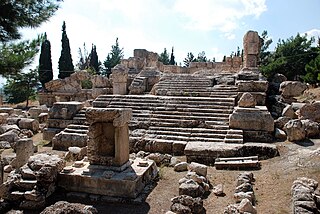
The following outline is provided as an overview of and topical guide to classical architecture:

In Hellenistic Greek and Roman architecture, a peristyle is a continuous porch formed by a row of columns surrounding the perimeter of a building or a courtyard. Tetrastoön is a rarely used archaic term for this feature. The peristyle in a Greek temple is a peristasis (περίστασις). In the Christian ecclesiastical architecture that developed from the Roman basilica, a courtyard peristyle and its garden came to be known as a cloister.

Greek temples were structures built to house deity statues within Greek sanctuaries in ancient Greek religion. The temple interiors did not serve as meeting places, since the sacrifices and rituals dedicated to the respective deity took place outside them, within the wider precinct of the sanctuary, which might be large. Temples were frequently used to store votive offerings. They are the most important and most widespread building type in Greek architecture. In the Hellenistic kingdoms of Southwest Asia and of North Africa, buildings erected to fulfil the functions of a temple often continued to follow the local traditions. Even where a Greek influence is visible, such structures are not normally considered as Greek temples. This applies, for example, to the Graeco-Parthian and Bactrian temples, or to the Ptolemaic examples, which follow Egyptian tradition. Most Greek temples were oriented astronomically.

An anta, or sometimes parastas, is an architectural term describing the posts or pillars on either side of a doorway or entrance of a Greek temple – the slightly projecting piers which terminate the walls of the naos. It differs from the pilaster, which is purely decorative, and does not have the structural support function of the anta.

Archaeology of Lebanon reveals thousands of years of history ranging from the Lower Palaeolithic, Phoenician, Jewish, Roman, Muslim, Christian, Ottoman, and Crusades history.

Labweh, Laboué, Labwe or Al-Labweh is a village at an elevation of 950 metres (3,120 ft) on a foothill of the Anti-Lebanon mountains in Baalbek District, Baalbek-Hermel Governorate, Lebanon. It is famous because of the archaeological remains, like a Roman temple converted in a Byzantine fortress.

Kfar Qouq is a village in Lebanon, situated in the Rashaya District and south of the Beqaa Governorate. It is located in an intermontane basin near Mount Hermon near the Syrian border, approximately halfway between Jezzine and Damascus.

Aaiha is a village, plain, lake, and temporary wetland situated in the Rashaya District and south of the Beqaa Governorate in Lebanon. It is located in an intermontane basin near Mount Hermon and the Syrian border, approximately halfway between Rashaya and Kfar Qouq.

Dakoue is a village located 3 kilometres (1.9 mi) southwest of Mejdel Anjar, Lebanon. It is predominantly inhabited by shepherds and farmers.

The architecture of Lebanon embodies the historical, cultural and religious influences that have shaped Lebanon's built environment. It has been influenced by the Phoenicians, Romans, Byzantines, Umayyads, Crusaders, Mamluks, Ottomans and French. Additionally, Lebanon is home to many impressive examples of modern and contemporary architecture. Architecturally notable structures in Lebanon include ancient thermae and temples, castles, churches, mosques, hotels, museums, government buildings, souks, residences and towers.

The Temples of Mount Hermon are around thirty Roman shrines and Roman temples that are dispersed around the slopes of Mount Hermon in Lebanon, Israel and Syria. A few temples are built on former buildings of the Phoenician & Hellenistic era, but nearly all are considered to be of Roman construction and were largely abandoned during the persecution of pagans in the late Roman Empire.

Aaqbe, Akbeh, Aqbe, Akbe, Aaqabet, el-Aaqbe, Akraba, Aaqabet Rashaya or Akabe (العقبه) is a village and municipality situated 3 kilometres (1.9 mi) west of Rashaya in the Rashaya District of the Beqaa Governorate in Lebanon.

Khirbet El-Knese, El-Knese or El Knese are two Roman temples south of Yanta, north of Rashaya in the Rashaya District of the Beqaa Governorate in Lebanon.

Saraain El Faouqa is a village located 6 kilometres (3.7 mi) northeast of Rayak in Baalbek District, Baalbek-Hermel Governorate, Lebanon. Most of its inhabitants Shia Muslims and a minority are Maronites.

The Temples of the Beqaa Valley are a number of shrines and Roman temples that are dispersed around the Beqaa Valley in Lebanon. The most important and famous are those in Roman Heliopolis. A few temples are built on former buildings of the Phoenician & Hellenistic era, but all are considered to be of Roman construction and were started to be abandoned after the fourth century with the fall of the Roman Paganism.

Yammoune is a lake, nature reserve, village and municipality situated 27 kilometres (17 mi) northwest of Baalbek in Baalbek District, Baalbek-Hermel Governorate, Lebanon. The village has a few hundred inhabitants.

Qasr el Banat is an ancient temple situated 1.5 kilometres (0.93 mi) east of Chlifa in the Baalbek District of the Beqaa Governorate in the city of Qsarnaba (Lebanon).
Kafr Zabad is a village in Lebanon. It is also the site of two ancient Roman antae temples.

In classical architecture, distyle in antis denotes a temple with the side walls extending to the front of the porch and terminating with two antae, the pediment being supported by two pilasters or sometimes caryatids. This is the earliest type of temple structure in the ancient Greek world. An example is the Siphnian Treasury in Delphi, built around 525 BCE.

The Roman temple of Bziza is a well-preserved first century AD building dedicated to Azizos, a personification of the morning star in the Canaanite mythology. This Roman temple lends the modern Lebanese town of Bziza its current name as Bziza is a corruption of Beth Azizo meaning the house or temple of Azizos. Azizos is identified as Ares by Julian the Apostate.














